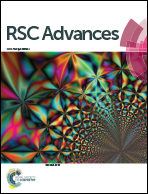Polylactic acid nanocomposite films with spherical nanocelluloses as efficient nucleation agents: effects on crystallization, mechanical and thermal properties†
Abstract
The low crystallization rate of commercial polylactic acid (PLA) restricts its application in food packaging materials. In this work, spherical nanocellulose formates (SCNFs) were incorporated into a PLA matrix to fabricate green nanocomposites. The addition of well-dispersed SCNFs significantly increased the crystallization rate, and thus led to obvious enhancements of the mechanical performance and thermal stability of the PLA. Compared to pure PLA, 130% and 116% improvements for the tensile strength and Young’s modulus can be obtained for the resulting nanocomposite with 10 wt% SCNFs, respectively, and the initial degradation temperature (T0) and maximum degradation temperature (Tmax) increased by 17.4 and 21.5 °C, respectively. This was ascribed to the good SCNF dispersability within the PLA matrix, the improved interfacial interaction and good crystallization ability of the PLA. Furthermore, the addition of SCNFs improved the barrier and overall migration properties of the nanocomposite as potential food packaging.


 Please wait while we load your content...
Please wait while we load your content...